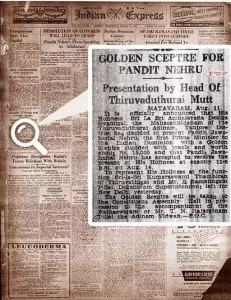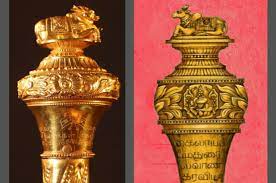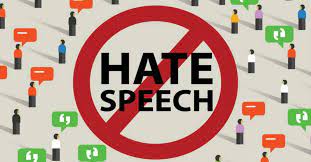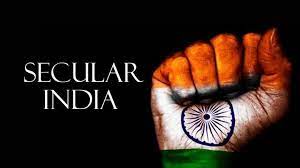
Sengol is regarded as a representation of justice, the handover of power, and sound government. On August 14, 1947, it was given to Jawaharlal Nehru, the nation of India’s first prime minister. This event served as the official handover of authority from the British Government to India.
Nothing encapsulates the importance of Sengol or sceptre more than the words spoken by Chera King Cheran Senguttuvan in Silapathikaram, the first Tamil epic with the common man and woman as hero and heroine. When he heard about the death of Pandiyan Nedunchezhian, the King of Madurai, Chera King Cheran Senguttuvan says, “Pandiyan offered his life and restored the uprightness of Sengol bent by the fate of injustice.”
Pandiyan fell from his throne and died after realising that he had committed an injustice by mistakenly ordering capital punishment to Kovalan, the hero and husband of Kannagi, the heroine. “Am I a king? I am a thief,” he utters before his death.
The word Sengol first surfaced after “unofficial” reports in the media that a “historical and sacred” symbol received by India’s first Prime Minister Jawaharlal Nehru was lying unheard of in the Allahabad museum along with his other items and that it will be given its due place of pride in the new Parliament building on May 28.
It is placed next to the Chair of the Lok Sabha following a proper religious ceremony in which religious heads from across India participated. They include representatives of the Thiruvavaduthurai Adheenam that were given the task of getting the Sengol ready for the transfer of power.
Some lesser known facts about the Sengol:
- The Hindu : 11 August 1947 issue was first to mentioned about Pandit Nehru setting Gold Sengol at his home.
- Indian Express : 13 August 1947 (Madras Edition) mentioned that Pandit Nehru will be getting Gold Sengol worth 15,000 Indian Rupee from Sri La Sri Ambalavana Desika Swamigal, the seer of the Thiruvaduthurai Adheenam at the time.

- Time Magazine 25 Aug 1947
Even someone like Jawahar Lal Nehru got Sengol after proper traditi0nal ceremony. An article about this was published in Time magazine 25 August 1947 issue.

- Sengol is mentioned in famous book “Freedom at Midnight” by Dominique Lapierre and Larry Collins.

Most of the references are indicating that it was a religious ceremony at his Delhi residence. There is neither mention of giving Sengol to Mountbatten and consecrating it with water in these contexts, nor is there anything clearly written about giving it as a symbol of transfer of power from the British.





Wonderful topics